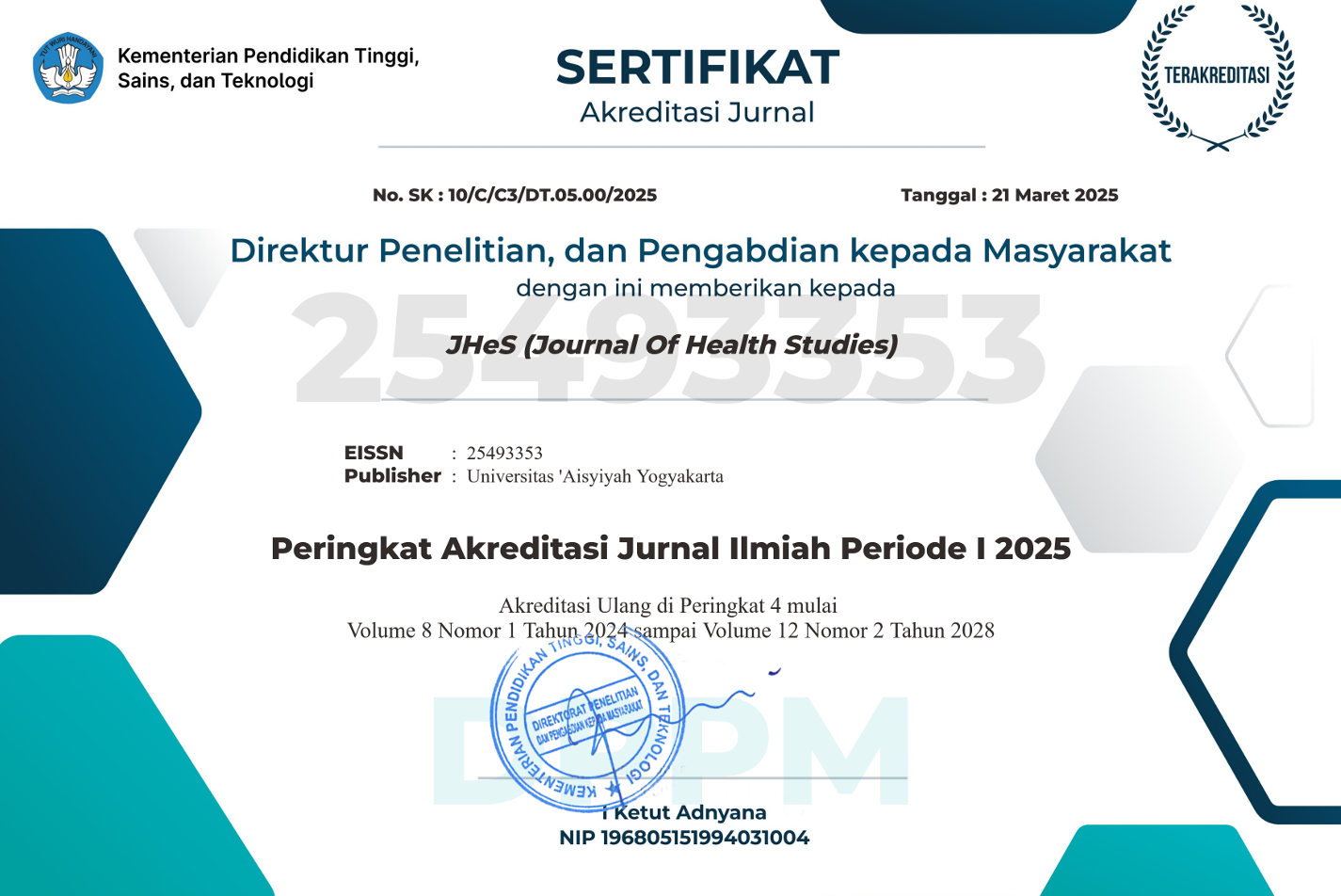Faktor risiko jatuh pada lansia di Panti X Surabaya
DOI:
https://doi.org/10.31101/jhes.1012Abstract views 2048 times
Keywords:
faktor risiko, risiko jatuh, lansiaAbstract
Downloads
References
Asnandra, Novan. (2009). Uji Reliabilitas Time up and go Test Pada Lansia Perempuan. Politeknik Kesehatan Surakarta.
Austin, Nicole A. D. (2007). Fear of Falling in Older Women: A Longitudinal Study of Incidence, Persistence, and Predictors. Journal of the American Geriatrics Society , 1598-1603.
De Villiers, L. (2015). An approach to balance problems and falls in elderly persons. South African Medical Journal.
Dewi, S. R. (2014). Buku ajar keperawatan gerontik. Yogyakarta: Deepublish.
Friedman, S. M., Munoz, B., West, S. K., Rubin, G. S., & Fried, L. P. (2002). Falls and fear of falling: which comes first? a longitudinal prediction model suggests strategies for primary and secondary prevention. American Geriatrics Society, 50:1329-13, (papers://85b7707d-3a9d-4f30-bc5c-df0ee0c38a87/Paper/p8739).
Grabiec, J. D., Snela, S., Rykala, J., Podgorska, J., & Banas, A. (2013). Changes in the body posture of women occurring with age. BMC Geriatrics, 13, (http://doi.org/10.1186/1471-2318-13-108).
Greenberg, S. A. (2011). Assessment of fear of falling in older adults: the falls efficacy scale-international (FES-I). Hartford Institute for Geriatric Nursing, 45(29), (http://doi.org/10.1159/000320054.Kempen).
Jette, Allan. (2012). Fear of falling in older person. Public Health Nursing, 1-8.
Kemenkes. (2013). Riset kesehatan dasar. Retrieved Juli 20, 2016, (www.depkes.go.id/resources/download/general/Hasil%20Riskesdas%202013.pdf).
Kemenkes. (2014). Situasi dan Analisis Lanjut Usia. Infodatin , 1-8.
Lopes, C. S. (2009). Prevalence of fear of falling among a population of older adults and its correlation with mobility, dynamic balance, risk and history of falls. Brazilian Journal of Physical Therapy, 223-226.
Murphy, S. (2002). Characteristics associated with fear of falling and activity restriction in community-living older persons. Journal of the American Chemical Society, 516-520.
Nilsson, Martin., Eriksson, Joel., Larsson, Berit., Oden, Ander., Johansson, Helena., Lorenzton, Mattias. (2016). Fall risk assessment predicts fallâ€related injury, hip fracture, and head injury in older adults. Journal of the American Geriatrics Society, 64(11).
Pluij, S. T. (2006). A risk profile for identifying community-dwelling elderly with a high risk of recurrent falling: results of a 3-year prospective study. International Osteoporosis Foundation and National Osteoporosis Foundation, 417–425.
Remilton, N. (2008). The Validity and Reliability Elderly Mobility Scale. Internet Journal Allied Health Science Pract., 60.
Sattin, R. W., Easley, K. A., Steven, M. S., & Kutner, M. H. (2005). Reduction in fear of falling through intense tai-chi exercise training in older, transitionally frail adults. American Geriatrics Society, 53(7), 1168–1178. (http://doi.org/10.1111/j.1532-5415.2005.53375.x).
Stephen Lord, C. S. (2001). Falls in older people risk factos and strategies for prevention. England: Cambridge University Press.
Sunarto, B. Y. (2014). Buku ajar boedhi-darmojo geriatri (ilmu kesehatan usia lanjut). Jakarta: Fakultas Kedokteran Universitas Indonesia.
Surgeons Panel on Falls. (2001). Guidelines for the prevention of falls in older persons. Journal of the American Geriatrics Society, 49:664–672.
Taylor, Morag M. K. (2012). Gait impairment and falls in cognitively impaired older adults: an explanatory model of sensorimotor and neuropsychological mediators. Age and Ageing , 665-669.
World Health Organization. (2004). What are the main risk factors for falls amongst older people and what are the most effective interventions to prevent these falls ? United Kingdom: Health Evidence Network.
World Health Organization. (2007). WHO global report on falls prevention in older age. Perancis: WHO.
Downloads
Published
Issue
Section
License
With the receipt of the article by the Journal of Health Studies Editorial Board and the decision to be published, then the copyright regarding the article will be diverted to Journal of Health Studies. Universitas 'Aisyiyah Yogyakarta as the publisher of Journal of Health Studies hold the copyright regarding all the published articles in this journal.
Journal of Health Studies is licensed under a Creative Commons Attribution-ShareAlike 4.0 International License.













